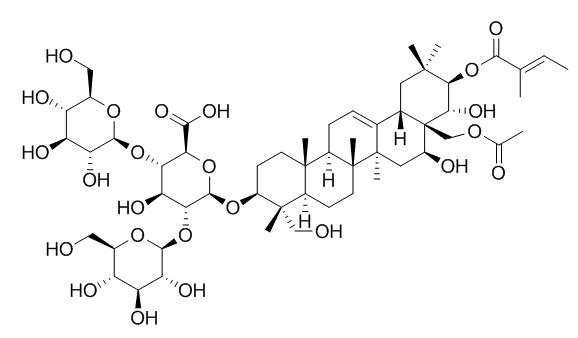Isoescin IA
Escin Ia and Isoescin IA have been traditionally used clinically as the chief active ingredients of escin, a major triterpene saponin isolated from horse chestnut (Aesculus hippocastanum) seeds for the treatment of chronic venous insufficiency, hemorrhoids, inflammation and edema.
Inquire / Order:
manager@chemfaces.com
Technical Inquiries:
service@chemfaces.com
Tel:
+86-27-84237783
Fax:
+86-27-84254680
Address:
1 Building, No. 83, CheCheng Rd., Wuhan Economic and Technological Development Zone, Wuhan, Hubei 430056, PRC
Providing storage is as stated on the product vial and the vial is kept tightly sealed, the product can be stored for up to
24 months(2-8C).
Wherever possible, you should prepare and use solutions on the same day. However, if you need to make up stock solutions in advance, we recommend that you store the solution as aliquots in tightly sealed vials at -20C. Generally, these will be useable for up to two weeks. Before use, and prior to opening the vial we recommend that you allow your product to equilibrate to room temperature for at least 1 hour.
Need more advice on solubility, usage and handling? Please email to: service@chemfaces.com
The packaging of the product may have turned upside down during transportation, resulting in the natural compounds adhering to the neck or cap of the vial. take the vial out of its packaging and gently shake to let the compounds fall to the bottom of the vial. for liquid products, centrifuge at 200-500 RPM to gather the liquid at the bottom of the vial. try to avoid loss or contamination during handling.
J Sci Food Agric.2018, 98(3):1153-1161
Nutrients.2023, 15(6):1417.
Evid Based Complement Alternat Med.2022, 2022:1307173.
Nat Commun.2023, 14(1):8142.
Life (Basel).2023, 13(2):457.
Int J Mol Sci.2020, 21(22):8816.
Med Sci Monit.2019, 25:9499-9508
Molecules 2022, 27(3),1047.
Asian J Beauty Cosmetol2020, 18(3): 265-272.
J Agric Food Chem.2016, 64(35):6783-90
Related and Featured Products
J Ethnopharmacol. 2012 Jan 6;139(1):201-6.
Comparative pharmacokinetics and bioavailability of escin Ia and isoescin Ia after administration of escin and of pure escin Ia and isoescin Ia in rat.[Pubmed:
22094055 ]
Escin Ia and Isoescin IA have been traditionally used clinically as the chief active ingredients of escin, a major triterpene saponin isolated from horse chestnut (Aesculus hippocastanum) seeds for the treatment of chronic venous insufficiency, hemorrhoids, inflammation and edema.
To establish a sensitive LC-MS/MS method and investigate the pharmacokinetic properties of escin Ia and Isoescin IA in rats and the pharmacokinetics difference of sodium escinate with pure escin Ia and Isoescin IA. The absolute bioavailability of escin Ia and Isoescin IA and the bidirectional interconversion of them in vivo were also scarcely reported.
METHODS AND RESULTS:
Wister rats were administrated an intravenous (i.v.) dose (1.7 mg/kg) of sodium escinate (corresponding to 0.5mg/kg of escin Ia and 0.5mg/kg of Isoescin IA, respectively) and an i.v. dose (0.5mg/kg) or oral dose (4mg/kg) of pure escin Ia or Isoescin IA, respectively. At different time points, the concentrations of escin Ia and Isoescin IA in rat plasma were determined by LC-MS/MS method. Main pharmacokinetic parameters including t(1/2), MRT, CL, V(d), AUC and F were estimated by non-compartmental analysis using the TopFit 2.0 software package (Thomae GmbH, Germany) and statistical analysis was performed using the Student's t-test with P<0.05 as the level of significance.
After administration of sodium escinate, the t(1/2) and MRT values for both escin Ia and Isoescin IA were larger than corresponding values for the compounds given alone. Absorption of escin Ia and Isoescin IA was very low with F values both <0.25%. Escin Ia and Isoescin IA were found to form the other isomer in vivo with the conversion of escin Ia to Isoescin IA being much extensive than from Isoescin IA to escin Ia.
CONCLUSIONS:
Comparison of the pharmacokinetics of escin Ia and Isoescin IA given alone and together in rat suggest that administration of herbal preparations of escin for clinical use may provide longer duration of action than administration of single isomers. The interconversion of escin Ia and Isoescin IA when given alone indicates that administration of one isomer leads to exposure to the other.
Adv Pharm Bull. 2015 Nov;5(4):587-91.
Determination of Four Major Saponins in Skin and Endosperm of Seeds of Horse Chestnut (Aesculus Hippocastanum L.) Using High Performance Liquid Chromatography with Positive Confirmation by Thin Layer Chromatography.[Pubmed:
26819933]
To separate and quantify four major saponins in the extracts of the skin and the endosperm of seeds of horse chestnut (Aesculus hippocastanum L.) using ultrasonic solvent extraction followed by a high performance liquid chromatography-diode array detector (HPLC-DAD) with positive confirmation by thin layer chromatography (TLC).
METHODS AND RESULTS:
The saponins: escin Ia, escin Ib, Isoescin IA and isoescin Ib were extracted using ultrasonic extraction method. The optimized extraction conditions were: 70% methanol as extraction solvent, 80 °C as extraction temperature, and the extraction time was achieved in 4 hours. The HPLC conditions used: Zorbax SB-ODS-(150 mm × 2.1 mm, 3 μm) column, acetonitrile and 0.10% phosphoric acid solution (39:61 v/v) as mobile phase, flow rate was 0.5 mL min-1 at 210 nm and 230 nm detection. The injection volume was 10 μL, and the separation was carried out isothermally at 30 °C in a heated chamber. Results: The results indicated that the developed HPLC method is simple, sensitive and reliable. Moreover, the content of escins in seeds decreased by more than 30% in endosperm and by more than 40% in skin upon storage for two years.
CONCLUSIONS:
This assay can be readily utilized as a quality control method for horse chestnut and other related medicinal plants.



